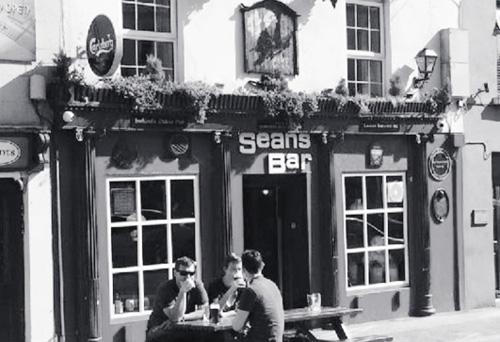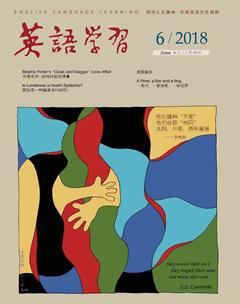一条河,一家酒吧,一块沼泽
By Christine Mc Cafferty

With very little money in their wallets, Shannon and Christine set off from Galway in the direction of the capital of the Republic of Ireland, Dublin. They had three goals to achieve: cross the River Shannon2, visit Seans bar (believed to be the oldest pub in Europe) and find a job in Dublin.
So off we went… just outside of Galway we got picked up almost immediately by a very sweet and friendly truck driver, John. This was typical of the Irish; the friendliest and most helpful people Id ever met. We told him our three goals. He said he could help us achieve two of them that day, the River Shannon and Seans Bar, and get us to Dublin the next… and then he added a new goal to our list: visit a peat factory:3 sure, theres a goal! We knew nothing about “peat” but were up for the adventure!
He was heading east and within an hour we crossed the River Shannon in the village of Shannon bridge. Shannon was thrilled. Her mothers family was from Ireland and she had always wanted to see the river she was named after. John stopped the truck and Shannon ran out and managed to get her hands wet in the river. She was incredibly pleased with herself!
Our truck driver carted peat briquettes around the country and was heading back to the factory where they are cut from the peat and made, near Croghan Hill in County Offaly, an area often referred to as the navel of Ireland.4 John eagerly gave us a tour of the factory. It was very interesting and, for what its worth, I now know how peat briquettes are made!
But what is peat? Peat is made up of thousands of years of partially decayed trees, mosses, heather, pollen, dust and such like that build up in wet soggy layers in what is known as a peat bog.5 After World War II, there was not enough coal in Ireland to burn for people to keep warm. They therefore started to use the peat for fuel and power generation6. It was cut, left to dry and then compressed7 into briquettes. First the job was done by hand and then in factories.
Far more interesting is what has been found in the peat. The first signs of human habitation in County Offaly go as far back as 6800—6000 BC. Stone axes, arrow heads and blades from this time period have been found in the peat bogs. The biggest stash of ancient artefacts found is from the Bronze Age,8 about 3000 years later. Known as the Dowris Hoard, it consists of bronze spearheads, axes, trumpets, a special kind of Irish bell and buckets—one of which was imported from elsewhere in Europe, showing that even back then the people were trading across the seas.9
In contrast to the kind and friendly Irish people we were meeting, were the mutilated10 and murdered bodies found in the bogs. Near to the peat factory is a place of significance throughout Irish history: Croghan Hill. There is a mound at the very top of the hill which is believed to be a Bronze Age burial site.11 It is near this hill that an important bog body was found—the headless torso of a man who seemingly had been tortured and then killed.12 He has been named Old Croghan Man by scientists. He was from the Iron Age13 and died in the centuries around 200 BC. His well-preserved hands reveal well-cared-for fingernails, showing that he had done very little physical labour in his life. He was 1.98 m tall, which is incredibly tall for a man of those times. Possibly he was a nobleman, or even a king, especially given that he was buried at Croghan Hill which was where rituals for choosing and crowning new kings took place.14
Disturbingly, it appears that the deep cuts under his nipples, something that was often done to indicate that a man was not worthy of being a king, were made while he was still alive.15 Holes were cut through his upper arms and a rope put through them in order to tie him. It appears he was killed by stabbing. Next, his head was cut off and his body cut in half. It must have been a brutal world!
There have been over 100 ancient bodies found in the bogs, many of them the victims of murder—and sometimes their bodies were mutilated in different ways. There is much conjecture16 over why some of them might have been killed. Maybe they were killed to appease17 pre-Christian gods, following bad luck. When people fell onto bad times, they often blamed the king too. If Old Croghan Man was a king, he might have been killed by his own people. Otherwise he might have been killed in a battle for leadership.
The bodies are well preserved because of the incredible properties18 of the peat. Even in modern times, mothers often put peat on a childs wound because of its healing power, and it is even being used in anti-aging beauty products and to treat everything from acne to AIDS symptoms.19
Modern scientific methods have helped us find out a great deal about the lives of the ancient bog bodies. But much of it remains a mystery—and it is all still educated guesses20. We added a new goal to our wish list, come face-to-face with a dead man from ancient times! The National Museum in Dublin, where we were headed, was the place to do it we were told.

Next we turned back in the direction we had come and headed west again with our trucker John to Athlone21. Athlone is on the River Shannon; a beautiful spot. After watching peat briquettes falling from a conveyor belt22 and learning about tortured victims all day, we were keen for something more light-hearted and headed to find Seans Bar.
The bar dates back to AD 900 and is regarded as Irelands oldest bar. Records have been kept of every owner since those times. Ancient coins were found during renovations23. Many believe it to be the longest-running bar in Europe. The people in the little bar were jovial and fun, even in the afternoon(!), and we had something else to tick off our list.24
We continued on our trucking journey with John. It was getting late and he insisted we go back to his home in the town of Clara for the night; in fact hed been talking about it, and a party “we” were all invited to, all day. It didnt take much to convince us. Once there, his wife and children greeted us with excitement and joy. We all sat in the lounge while they sang and played musical instruments for us. What a lovely family. It was almost overwhelming25.
They took us along to the birthday party nearby. There was raucous26 country-style dancing to Irish folk music until the party was broken up by the police at 2am and everyone sent home. We chatted late and only got to bed at about 4am, but were up only a few hours later to head off with John to Dublin.
Off we went. Ireland is pretty small so crossing it does not take more than three hours, even by truck. Just as well because we sure were crisscrossing and going to and fro on our journey.27 John took us by peat delivery truck over OConnell Bridge in the heart of Dublin, passed the famous Trinity College28 and dropped us off at the National Museum of Ireland. We decided that seeing dead bodies had to be done before finding a job… probably because we knew wed have more success at the former than the latter. We had hardly spent a penny of our last few pounds; how lucky we were that the beautiful people of Ireland had been so kind.
Read next month when Shannon and Christine come face to face with bog bodies, fresh Guinness beer (the most famous drink in Dublin) and try to find a job. Will they finally get work and money rolling in the pockets?
1. bog: 泥塘,沼澤。
2. Shannon River: 香侬河,爱尔兰最长的河流。
3. Seans Bar: 肖恩酒吧,《吉尼斯世界纪录大全》记载的爱尔兰最古老的酒吧;peat: 泥炭,泥煤。
4. 送我们的这位卡车司机平时开车在全国运送泥炭饼,现在要回到分离、制作泥炭饼的工厂去,工厂在奥法利郡的克罗根山附近,那里常被人们称为爱尔兰的中心。cart: 用车运送;briquette: 煤球,煤饼;Croghan Hill: 克罗根山,位于爱尔兰中部的艾伦沼泽上,是一个石炭纪死火山遗迹;navel: 肚脐。
5. 构成泥炭的是一些累积了几千年的物质,包括部分腐烂的树木、苔藓、石南植物、花粉、尘土等等,而这些物质也是泥炭沼泽中潮湿层的组成部分。heather:石南属植物;pollen: 花粉;soggy: 潮湿的,沉闷的;peat bog: 泥炭沼泽,指土壤剖面发育有泥炭层的沼泽。
6. power generation: 发电。
7. compress: 压缩。
8. stash: 储藏处;artefact: 人工制品,加工品;Bronze Age: 青铜时代,在考古学上以使用青铜器为标志的人类文明发展的一个阶段,在欧洲约为公元前3200—前600年。
9. 这里名为道里斯堆(Dowris Hoard),包括铜矛、斧头、小号、一种独特的爱尔兰铃铛和木桶,其中有一个是从欧洲其他地方进口的,说明那时候人们就已经有跨海贸易了。Dowris Hoard: 铜器时代一处重要的宝藏,因在爱尔兰奥法利郡道里斯地区发现而得名,hoard意为“贮藏物,囤积物”;spearhead:矛;trumpet: 小号。
10. mutilate: 使(肢体)残缺。
11. mound: 土石堆,土丘;burial site: 墓地。
12. bog body: [考古学] 泥炭沼人(在泥炭沼泽里自然形成的木乃伊);torso: 人體躯干。
13. Iron Age: 铁器时代,继青铜时代之后的人类社会发展时代。大约从公元前1000年开始,欧洲各国逐渐进入铁器时代。
14. ritual: 仪式;crown: 为……加冕。
15. 非常令人不安的是,在他乳头下面有一些很深的伤口,看起来是在他活着的时候造成的,这通常是说明这个人没有资格成为国王。disturbingly: 令人不安地。
16. conjecture: 猜测。
17. appease: 平息,使……安静。
18. property: 性能,功效。
19. 哪怕是在近代,母亲们也会把泥炭敷在孩子的伤口上面,因为泥炭有治愈的功效,它甚至被用在抗衰老美容产品当中,还用来治疗包括粉刺和艾滋病在内的各种疾病。acne: 粉刺,痤疮。
20. educated guess: 有根据的猜测。
21. Athlone: 阿斯隆,爱尔兰一城市。
22. conveyor belt: 传送带。
23. renovation: 翻新,重修。
24. jovial: 愉快的,快乐的;tick off: 用记号标出,从(列表中)勾掉。
25. overwhelming: (感情)强烈的,无法抗拒的。
26. raucous: // 混乱的,闹哄哄的。
27. criss-cross: 交叉往返;to and fro: 往返地,来回地。
28. Trinity College: 都柏林圣三一学院,爱尔兰最古老的大学。

